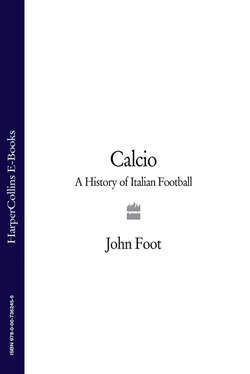Читать книгу Calcio: A History of Italian Football - John Foot - Страница 72
The Party. 1987
ОглавлениеOn 10 May 1987, Napoli needed just a draw at home to Fiorentina to win their first scudetto. Carnevale scored for Napoli, and Roberto Baggio struck his first-ever goal in Serie A to equalize in the first half. No further goals were added. During the game, apart from the cheers after Napoli’s goal, the city was as quiet as a grave. Italian anthropologist Amalia Signorelli went for a walk (it was a beautiful day). ‘The world had changed,’ she wrote, ‘the noisiest, most crowded and most chaotic city in Europe was deserted.’14
As the final whistle blew, Neapolitans poured onto the streets all over the city, and in cities all over the world. ‘By 7.30 along the sea front…there was a single wave of Napoli flags, a long singing, dancing, jumping blue snake.’15 Hundreds of buses were blocked in the crowd, with fans dancing on their roofs. Motorbike riders did wheelies all over town. Many revellers were dressed as Maradona, with curly black wigs. An enormous replica trophy was stuck on to a Dante statue. Blue cakes between six and ten metres long were displayed, and then eaten. The omens had been good. Number 43 had come up in the lottery for the Naples wheel (each city has a daily lottery); 43 stands for ‘the god of players’ – Maradona, in other words. A week later, 43 came up again, along with 61 (the number of years it had taken Napoli to win the championship). During the celebrations, Napoli’s fans displayed all the classic traits of what has become known as the Neapolitan ‘character’: irony, parody and a sense of the macabre, obscenity, blasphemy. They also put on a show, and did so knowingly. Already, during the celebrations, illegal VHS cassettes of the same celebrations were being sold on the streets. This was theatre. Neapolitans were being filmed and then buying videos showing themselves celebrating the victory of Napoli.
Bunting was hung across the claustrophobic streets – the vicoli – of the city centre, and cars were draped in Napoli colours as they honked their way through town. Impromptu street parties went on for days, with pasta and seafood being prepared for all and sundry on massive long tables. Anybody could sit down for a meal. Citizens ‘taxed themselves’ to pay for all this. Fireworks exploded at frequent intervals. Nobody went to work the next day. Famously, someone wrote this graffito on the walls of the city graveyard: ‘You don’t know what you are missing!’ – Guagliu! E che ve sit pers! Pretend funerals were held for Juventus, complete with coffins and black-lined printed ‘death notices’. Napoli’s victory was also the chance of revenge after years of being seen as a poor city full of thieves. ‘May 1987, the other Italy has been defeated, a new empire is born.’ Urban myths circulated concerning the power of Maradona. It was said that 20,000 local government voters had written ‘Viva Maradona’ on their ballot papers, making their votes uncountable. Another improbable myth was that 100 donkeys had been imported from Sardinia for the post-scudetto celebrations. Floats were prepared with Maradona on a throne and Platini or Rummenigge prone at his feet.
During Maradona’s time in the city, thousands of babies were named ‘Diego’, or even Diega. In one central parish 25 per cent of newly born sons were named Diego. Streets and whole neighbourhoods were given his name and murals sprang up comparing him to the city’s much-loved patron saint, San Gennaro. In one such mural Maradona is depicted in the arms of San Gennaro himself. Many of these murals are now painted over or in a poor state of repair. One of the most interesting and important ‘social centres’ (alternative city spaces) in Naples is called DAMM: Diego Armando Maradona Montesanto.16 The cult of Diego was (and is) a real cult, combining idolatry, superstition and love. On one website dedicated to Maradona, there is a photo of his baptism. Many writers have stressed the ways in which Maradona was accepted by Neapolitans as one of them – in part because of his humble background, and in part because of his ‘rebellious’ nature. Maradona, according to Spanish writer Manuel Vazquez Montalbán, ‘encapsulated the myth of lumpenproletarian emancipation’. Short, scruffy, ugly and ungainly, Maradona even looked like a grown-up street kid (which is what he was, after all) and the Neapolitans loved him for it. Northern journalist Gianni Brera played on the contradiction between Diego’s physical appearance and his grace on the field, dubbing him ‘the divine abortion’.
By 1987, after just three years in the city, Maradona had won the World Cup (and there was much celebrating in Napoli after Argentina’s victory) and taken a much-loved team to its first scudetto in sixty-one years of Italian football. He was at the peak of his career. Sadly, from that moment on, self-destruction set in. He won a few more trophies with Napoli – including a controversial second championship – and took a weak Argentinian team close to another World Cup in 1990, but after 1987, Maradona would be in the headlines more for his private life than his performances on the field. His long slide into addiction and obesity was aided and abetted by nasty hangers-on, some unwisely chosen by Maradona himself, and by a sense that he was above any discipline and management. Diego’s relationship with Corrado Ferlaino, Napoli’s president since 1969, was always stormy and it is said that the club paid for private detectives to monitor his every move. These costs were even declared in the club’s official budget. However, the club ‘managed’ Diego by basically allowing him to do what he liked, as long as he turned up for matches, and this indiscipline soon spread to the rest of the team.
